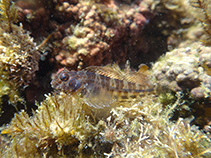| Family: |
Blenniidae (Combtooth blennies), subfamily: Salariinae |
| Max. size: |
6.8 cm SL (male/unsexed) |
| Environment: |
reef-associated; marine |
| Distribution: |
Western Central Atlantic: Caribbean to South Florida. |
| Diagnosis: |
Dorsal spines (total): 12-12; Anal spines: 2-2. Species distinguished by: black spot on membrane between first 2 dorsal-fin spines; mandibular sensory pore series with 5 pores per side (south Florida to Brazil); upper half of body with groups of spots forming 6 partial bars along dorsum; no orange spots in life; pelvic fins with 1 spine and 4 soft rays; pectoral-fin soft rays usually 13 or 14; segmented caudal-fin soft rays usually 13; dorsal fin not separated into 2 portions by deep notch (notch, when present, not reaching nearly to dorsal contour of body); dorsal-fin spines usually 12, the last easy to see; total dorsal-fin elements 25 to 30; an enlarged canine tooth present posteriorly on both sides of 1 or both jaws (sometimes absent on 1 side); no teeth on vomer; gill openings not continuous, each restricted to side of head, extending ventrally to about midlevel of pectoral-fin base or further (may extend completely around lower side of head and form common opening with gill opening of opposite side); cirri present only on eyes; ventral edge of upper lip smooth; lateral line never consisting of 2 disconnected, overlapping portions. Common amongst Blenniids: small, slender fishes, largest species to about 13 cm SL, most under 7.5 cm SL. Eyes high on sides of head; mouth ventral, upper jaw not protractile. A single row of incisor-like teeth in each jaw and often an enlarged canine-like tooth posteriorly on each side of lower jaw and sometimes upper jaw; no teeth on palatines. Dorsal and anal fins long, their spines usually flexible; dorsal fin with fewer spines than segmented (soft) rays; 2 spines in anal fin, scarcely differentiated from the segmented rays, the first not visible in females, both often supporting fleshy, bulbous, rugose swellings at their tips in males; pelvic fins inserted anterior to base of pectoral fins, with 1 spine (not visible) and segmented rays; all segmented fin rays, except those of caudal fin, unbranched (simple), caudal-fin rays of adults branched. All species lack scales (Ref.52855). |
| Biology: |
Oviparous. Eggs are demersal and adhesive (Ref. 205), and are attached to the substrate via a filamentous, adhesive pad or pedestal (Ref. 94114). Larvae are planktonic, often found in shallow, coastal waters (Ref. 94114). |
| IUCN Red List Status: |
Least Concern (LC); Date assessed: 18 October 2007 Ref. (130435)
|
| Threat to humans: |
harmless |
Source and more info: www.fishbase.org. For personal, classroom, and other internal use only. Not for publication.

